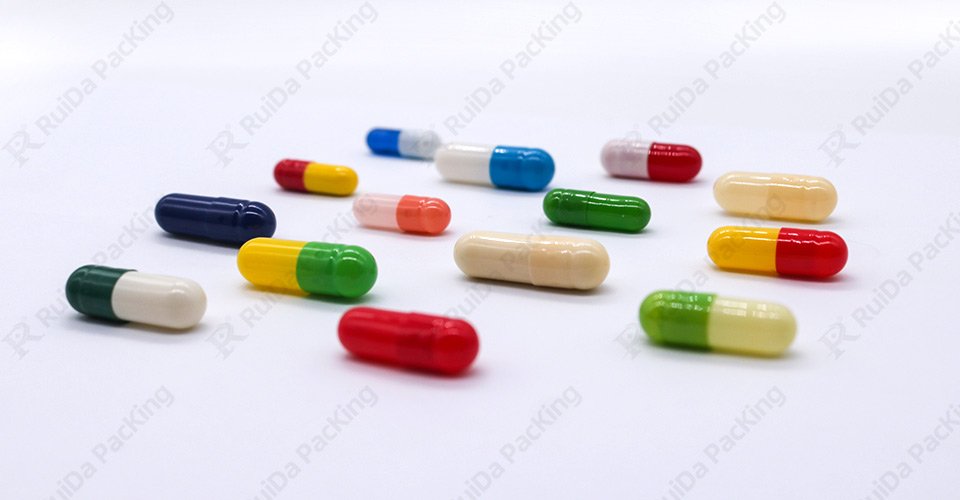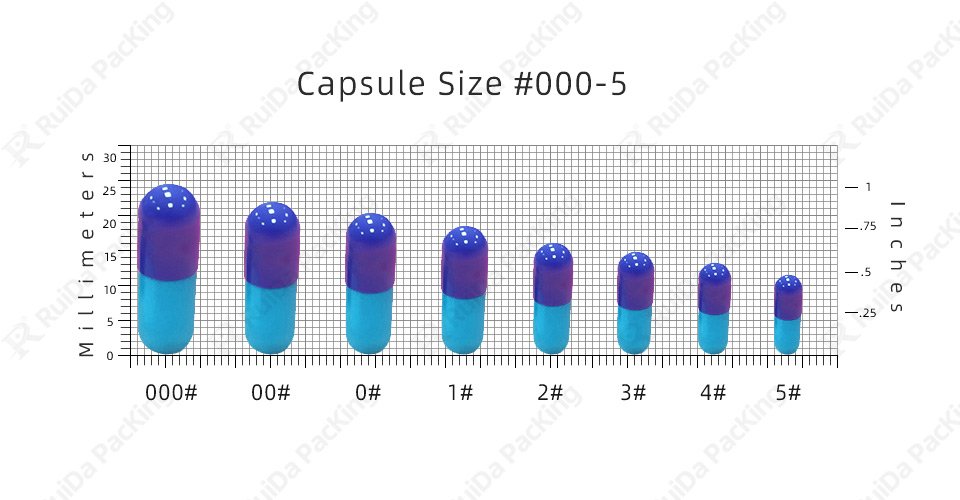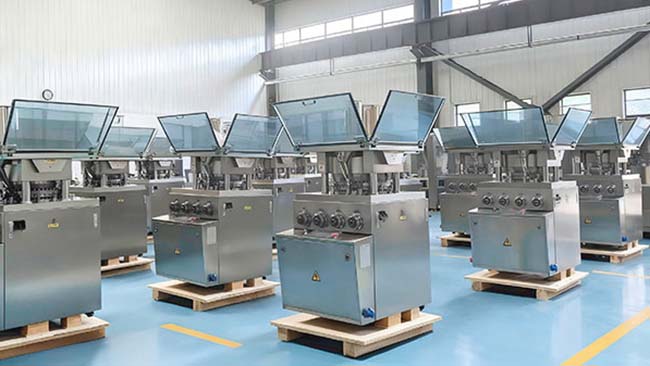
What Are the Most Common Capsule Sizes?
Understanding the most common capsule sizes is the first step to guarantee that your product meets the market demands. In the pharmaceutical and supplement industries, standard capsule sizes are typically named by numbers, with sizes labeled as #000, 00, 0, 1, 2, 3, 4, and 5. Size 000 is the largest, while size 5 is the smallest. These sizes are widely used by most international capsule filling machine manufacturers, offering excellent compatibility. Below is a comparison chart of the capsule sizes from 000 to 5, helping you select the most suitable one based on the specific needs of your product.| Capsule Size | 000 | 00 | 0 | 1 | 2 | 3 | 4 | 5 |
| Empty Capsule Volume (ml) | 1.37 | 0.95 | 0.68 | 0.5 | 0.37 | 0.3 | 0.21 | 0.13 |
| Empty Capsule Weight (Gelatin) (mg) | 158 | 123 | 97 | 76 | 63 | 52 | 42 | 33 |
| Empty Capsule Weight (Vegetarian) (mg) | 163 | 128 | 102 | 80 | 65 | 54 | 44 | 35 |
| Weight Capacity by Formula Density (mg) | 800 – 1600 | 600 – 1200 | 400 – 800 | 300 – 600 | 250 – 500 | 200 – 400 | 150 – 300 | 100 – 200 |
| Total Closed Capsule Length (mm) | 26.14 | 23.3 | 21.7 | 19.4 | 18 | 15.9 | 14.3 | 11.1 |
| Individual Capsule Length (Cap) (mm) | 12.92 | 11.8 | 10.85 | 9.98 | 9 | 8.12 | 7.21 | 6.6 |
| Individual Capsule Length (Body) (mm) | 23.3 | 20.22 | 18.75 | 16.5 | 15.4 | 13.6 | 12.2 | 10.8 |
Why Choosing the Right Capsule Size Matters?
The size of a capsule not only determines the capacity of medication or supplement, but also affects the production efficiency and overall cost of the empty capsules. More importantly, it can significantly impact the consumer’s swallowing experience. Larger capsules, like size 000, can hold more ingredients, but they can be challenging for certain groups of consumers, especially the elderly, children, or anyone with difficulty swallowing. For these individuals, smaller capsules, such as size 3 or 4, are often much more acceptable.
How to Choose the Appropriate Capsule Size for Your Product?
Choosing the right capsule size involves several factors. It starts from assessing your product’s formulation, dosage, and target audience. For example, if you’re dealing with high-dose powdered supplements, you might need larger capsules, like size 00 or 000. On the other hand, for lower-dose formulas, such as trace element supplements, size 1 or 2 could be more appropriate.
It’s also essential to consider circumstances in which the capsules will be consumed. For instance, children and elderly generally prefer smaller capsules for ease of swallowing, while healthy adults are usually more comfortable with larger sizes.

What Are the Distinctions Between Gelatin Capsules and Vegetarian Capsules
When choosing capsules, the material is just as important as the size. There are two common types of capsule materials on the market: gelatin capsules and vegetarian capsules. These materials differ and cater to different consumer groups.
Cápsulas de gelatina
Gelatin capsules are typically made from collagen extracted from the animal’s skin, bones and tendons of animals, with the features of excellent biocompatible, non-toxic, biodegradable and low cost. This type of capsule is widely used in the pharmaceutical industry due to the fact that the cost of production is low and suitable for large-scale manufacturing.
Vegetarian Capsules
Vegetarian capsules are a great option for vegetarians and individuals with allergies to animal products. They are usually made from cellulose derivatives, making them suitable for a broader range of consumer needs, particularly in regions like Europe and North America.
Different capsule materials also have an impact on the size. Vegetarian capsules tend to be slightly thicker, so you may need to adjust the capsule size accordingly when making your selection.
How Capsule Size Affects Your Production Process?
In the process of massive production, the size of the capsules directly impacts the compatibility and production efficiency of the equipment. For different capsule sizes, your filling equipment must be able to adjust quickly and accurately to maintain a smooth production flow.
How to Match with Capsule Filling Machines?
Many automatic or semi-automatic capsule filling machines are compatible with various capsule sizes, ranging from size 000 to size 5. Simply change the molds of the capsule filling machine according to the size of the capsules. However, it’s essential to ensure that the equipment is flexible enough to switch between different capsule sizes in a short time. This is particularly important for companies that produce a variety of products. Choosing a machine with a modular design that allows quick and easy mold changes can significantly enhance efficiency and adaptability in the production line.
Capsule Size and User Preferences: What You Should Know?
The size of capsules not just affects production but also directly impacts consumers’ buying decisions. This is particularly true in the health supplement market, where users are very sensitive to the swallowing experience, appearance and size of capsules.
Special Needs of Specific Groups
If your product is targeted at children, the elderly, or individuals with swallowing difficulties, smaller capsule sizes will likely be more acceptable to them. On the contrary, if your product is primarily aimed at healthy adults, larger capsules may be more suitable, as they can hold more active ingredients, thus reducing the number of capsules needed to be taken daily.
In addition, the appearance of the capsules can also affect consumer choices. Larger, transparent capsules are often more popular in certain markets because they give the impression of being more “natural.” It’s essential to make the best choice based on the needs of your aimed market.

Capsule Size and Cost: How to Balance Efficiency and Price?
The size of capsules impacts your production costs. Larger capsules may require more material during manufacturing and packaging process, resulting in the increasement of the costs. However, they also reduce the filling time required for each capsule, thereby enhancing production efficiency.
On the other hand, smaller capsules tend to save space during packaging and transportation, potentially leading to lower logistics costs. If your production process involves using multiple capsule sizes, careful planning and adjustments to the production workflow can help you find the right balance between efficiency and cost.

Regulation of Capsule Size: Are You Meeting the Standards?
Capsule size is not only a matter of production and marketing strategy, but also involves regulatory compliance. Especially under the circumstances that you are selling to multiple international markets, you need to ensure that your products meet the size standards of the respective countries. For instance, in the United States, the FDA has strict requirements for capsule products, and similarly, the European Union has its own rules and regulations.
How to Ensure Compliance?
Before production, it’s essential to understand the regulatory requirements of your target market and ensure that both the capsule size and packaging meet local standards. In this way you can avoid issues such as failure of quality inspections or legal obstacles during sales due to size discrepancies.
Frequently Asked Questions: Common Questions about Capsule Sizes
– What capsule size should I choose for my product?
It depends on the product’s dosage, formulation, and target consumers. High-dose products typically require larger capsules, while lower-dose products are better suited for smaller capsules.
– Do I need to change equipment when switching capsule sizes?
Generally, most equipment like automatic capsule filling machine can accommodate different capsule sizes, but you may need to adjust or change the molds.
– Are larger capsules more expensive to produce?
Larger capsules do increase the cost of materials, but in some cases, you can save some other costs by reducing the daily dosage required.
– What is the best size for liquid capsules?
Liquid capsules typically use larger sizes, such as size 0 or 00, to ensure they can hold enough liquid.
Choosing the right capsule size is crucial for your product’s success. Whether it’s about enhancing production efficiency or ensuring consumer satisfaction, the size of the capsule is a factor that cannot be overlooked. We hope this guide helps you find the optimal capsule size to ensure your product stands out in the market.


